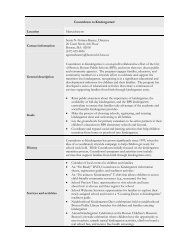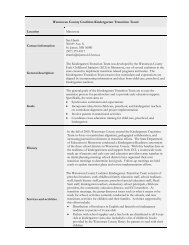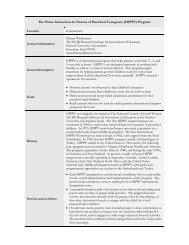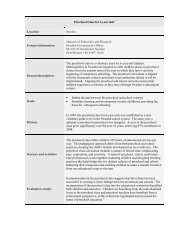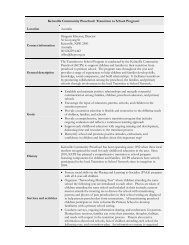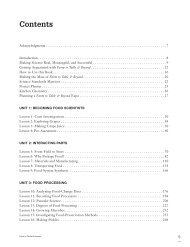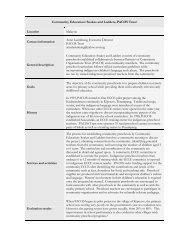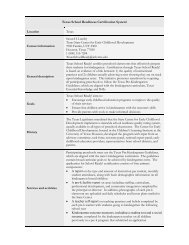Proceedings of the Fourth Annual Teachers College Educational ...
Proceedings of the Fourth Annual Teachers College Educational ...
Proceedings of the Fourth Annual Teachers College Educational ...
Create successful ePaper yourself
Turn your PDF publications into a flip-book with our unique Google optimized e-Paper software.
Design <strong>of</strong> computer assisted tools for bridging <strong>the</strong> gap between<br />
receptive vocabulary and expressive vocabulary for ESL learners<br />
Woonhee Sung, Junghyun Ahn<br />
<strong>Teachers</strong> <strong>College</strong>, Columbia University, 525 W. 120th street, New York, NY<br />
Email: ws2345@tc.columbia.edu, ja2178@tc.columbia.edu<br />
Abstract: For English as a Second Language (ESL) students, vocabulary learning<br />
is at <strong>the</strong> core <strong>of</strong> language learning and use. This implies that lexical errors and<br />
insufficient vocabulary size among L2 learners prevent effective communication<br />
(Gass & Selinker, 2008). Currently, <strong>the</strong> scarcity <strong>of</strong> systematic, intentional<br />
vocabulary teaching in ESL classroom, in particular, unpromising outcomes from<br />
widely spread pedagogy, usage <strong>of</strong> written context or extensive reading, call for<br />
new L2 vocabulary teaching methods. This highlights major pedagogical issues<br />
such as how ‘receptive vocabulary’ is transferred to ‘expressive vocabulary’ for<br />
writing and speaking. The tools designed here, Visual Vocabulary Map (VVM),<br />
supports ESL learners’ strategy development for learning, using, and producing <strong>the</strong><br />
words. This concept mapping based visual representation tool (VVM) would<br />
possibly bring <strong>the</strong> benefits <strong>of</strong> organizing information through visual aids showing<br />
<strong>the</strong> relationships among words, this paper argues how <strong>the</strong> tools can promote<br />
learning and increasing vocabulary size.<br />
Introduction<br />
One <strong>of</strong> <strong>the</strong> most common ways <strong>of</strong> teaching vocabulary is using written context or extensive reading to<br />
learn word definitions (Feldman & Kinsella, 2005) in ESL classrooms. However, a number <strong>of</strong> research<br />
studies indicate that <strong>the</strong> implicit approach is held up as problematic for L2 learning due to several<br />
reasons. First, it requires significant amounts <strong>of</strong> contextual guessing which unfortunately results in low<br />
rate <strong>of</strong> vocabulary acquisition (Beck et al. 2002; Nagy, Herman, & Anderson, 1985). Second, incidental<br />
vocabulary learning through reading leads to only a superficial understanding <strong>of</strong> many vocabulary words<br />
(Paribakht & Wesche, 1997). Third, due to sparse exposure over modest periods <strong>of</strong> time, implicitly<br />
acquired vocabulary is <strong>of</strong>ten available to <strong>the</strong> learner only via receptive channels (Wesche & Paribakht,<br />
2000).<br />
Therefore, this paper proposes <strong>the</strong> specific design <strong>of</strong> computer assisted concept mapping tool that would<br />
work as conduits <strong>of</strong> amplifying <strong>the</strong> process <strong>of</strong> transferring receptive vocabulary into expressive vocabulary<br />
based on <strong>the</strong> cognitive <strong>the</strong>ory <strong>of</strong> multimedia learning (Mayer, 2005), mental model <strong>the</strong>ory (Schwartz &<br />
Black, 1996) and situated cognition (Brown, Collins & Duguid, 1989).<br />
Visual Vocabulary Map (VVM) is an interactive word concept map for L2 vocabulary learning in which a<br />
user creates vocabulary maps that blossom with meanings and branch to related words. Its innovative<br />
visual display promotes each student’s independent word learning process in and out <strong>of</strong> <strong>the</strong> classroom<br />
environment. Findings from incidental vocabulary learning which leads to a superficial understanding <strong>of</strong><br />
vocabulary words, VVM was developed to address <strong>the</strong> urgent needs <strong>of</strong> targeted instruction for vocabulary<br />
learning (Paribakht & Wesche, 1997).<br />
Designing Theory<br />
Concept mapping is a strategy that helps learners organize information through visual aids by showing<br />
<strong>the</strong> relationships among concepts. In designing VVM, cognitive <strong>the</strong>ory <strong>of</strong> multimedia learning (Mayer,<br />
2005), mental model <strong>the</strong>ory (Schwartz & Black, 1996) and situated cognition (Brown, Collins & Duguid,<br />
1989) are conceptually framed to enhance vocabulary learning and retention. When a learner is<br />
processing information through a concept map, it stimulates learners’ meta-cognitive awareness, assists<br />
appropriate monitoring strategy and increases <strong>the</strong> use <strong>of</strong> retrieving and memorizing knowledge (Liu, Chen<br />
74



